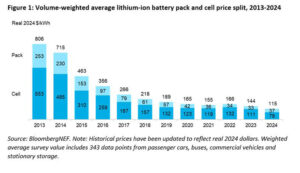Lithium-ion battery packs experienced the most significant price drop in seven years. A promising new material could help batteries achieve over 20,000 charge and discharge cycles before reaching the 80% capacity threshold, maximizing their value. Two new battery technologies could replace lithium-ion, and the Biden administration significantly boosted battery production and charging infrastructure with a large loan.
1. Lithium-ion battery pack prices plunge to $115 per kWh, marking the largest drop since 2017
 Battery prices have experienced their steepest annual decline since 2017, with lithium-ion battery pack costs falling by 20% to a global average of $115 per kilowatt-hour, according to BloombergNEF (BNEF). The drop is driven by several factors, including overcapacity in cell manufacturing, economies of scale, reduced metal and component costs, the increasing adoption of lower-cost lithium-iron-phosphate (LFP) batteries, and slower growth in electric vehicle (EV) sales.
Battery prices have experienced their steepest annual decline since 2017, with lithium-ion battery pack costs falling by 20% to a global average of $115 per kilowatt-hour, according to BloombergNEF (BNEF). The drop is driven by several factors, including overcapacity in cell manufacturing, economies of scale, reduced metal and component costs, the increasing adoption of lower-cost lithium-iron-phosphate (LFP) batteries, and slower growth in electric vehicle (EV) sales.
The decline comes amid aggressive production expansions by battery manufacturers over the past two years. Anticipating a surge in demand from EVs and stationary storage markets, global battery-cell manufacturing capacity now exceeds 3.1 terawatt-hours — more than 2.5 times the projected demand for lithium-ion batteries in 2024, BNEF reports.
While battery demand grew year over year across all sectors, the EV market, a key driver of lithium-ion battery demand, saw slower growth than in recent years. In contrast, the stationary storage sector has accelerated, with intense competition among cell and system providers, particularly in China.
Battery prices vary by region and application, but the global downward trend highlights the impact of manufacturing overcapacity and shifts in market dynamics.
“The price drop for battery cells this year was greater compared with that seen in battery metal prices, indicating that margins for battery manufacturers are being squeezed. Smaller manufacturers face pressure to lower cell prices to fight for market share,” said Evelina Stoikou, the head of BNEF’s battery technology team and lead author of the report.
2. New battery technology promises longer lifespan, extending use to grid energy storage after EVs
Efforts are ramping up to extend the lifespan of lithium-ion batteries in electric vehicles (EVs). In the U.S., current regulations require these batteries to retain 80% of their original capacity after eight years of use. However, many experts argue that batteries capable of lasting decades are needed to maximize their value. Once no longer suitable for EVs, these batteries could serve “second-life applications,” such as grid energy storage for wind and solar power.